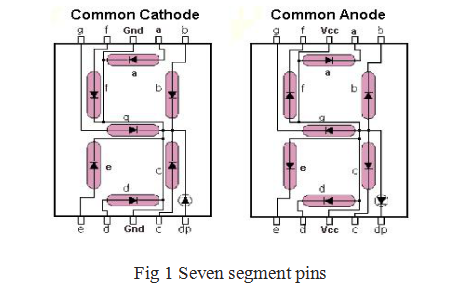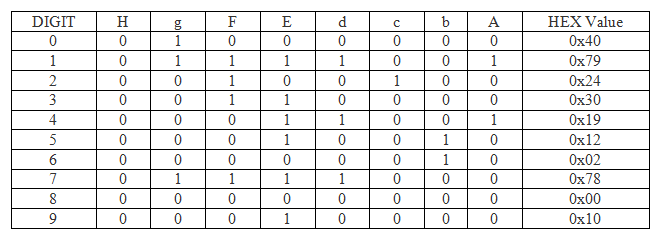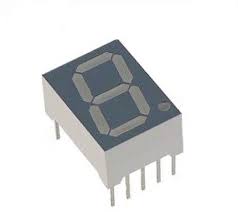

H-Segment dot led is Enable Table. (Common anode configuration)

H-Segment dot led is Disable Table. (Common anode configuration)

H-Segment dot led is Enable Table. (Common cathode configuration)

H-Segment dot led is Disable Table. (Common cathode configuration)

Applications:
/* Name : main.c
* Purpose : Source code for 7SEG-COMMON-ANODE Interfacing with AT89C52.
* Author : Gemicates
* Date : 2014-01-13
* Website : www.gemicates.org
* Revision : None
*/
#include <REGX52.H> // header file for AT89c52 series
#define seg_port P2 // GPIO direction register declaration
void delay(int msec) //delay function declaration
{
int i,j;
for(i=0;i<msec;i++)
for(j=0;j<1275;j++);
}
void main() //main function
{
seg_port = 0xFF; //Port 2 make as aoutput port
while(1)
{
seg_port = 0xFE; // 'A' segment turn on
delay(50);
seg_port = 0xFD; // 'B' segment turn on
delay(50);
seg_port = 0xFB; // 'C' segment turn on
delay(50);
seg_port = 0xF7; // 'D' segment turn on
delay(50);
seg_port = 0xEF; // 'E' segment turn on
delay(50);
seg_port = 0xDF; // 'F' segment turn on
delay(50);
seg_port = 0xBF; // 'G' segment turn on
delay(50);
seg_port = 0x7F; // 'H' segment turn on
delay(50);
// Default 'H' segment turn OFF
seg_port = 0x40; // Display '0'
delay(50);
seg_port = 0x79; // Display '1'
delay(50);
seg_port = 0x24; // Display '2'
delay(50);
seg_port = 0x30; // Display '3'
delay(50);
seg_port = 0x19; // Display '4'
delay(50);
seg_port = 0x12; // Display '5'
delay(50);
seg_port = 0x02; // Display '6'
delay(50);
seg_port = 0x78; // Display '7'
delay(50);
seg_port = 0x00; // Display '8'
delay(50);
seg_port = 0x10; // Display '9'
delay(50);
// Default 'H' segment turn ON
seg_port = 0xC0; // Display '0'
delay(50);
seg_port = 0xF9; // Display '1'
delay(50);
seg_port = 0xA4; // Display '2'
delay(50);
seg_port = 0xB0; // Display '3'
delay(50);
seg_port = 0x99; // Display '4'
delay(50);
seg_port = 0x92; // Display '5'
delay(50);
seg_port = 0x82; // Display '6'
delay(50);
seg_port = 0xF8; // Display '7'
delay(50);
seg_port = 0x80; // Display '8'
delay(50);
seg_port = 0x90; // Display '9'
delay(50);
}
}


